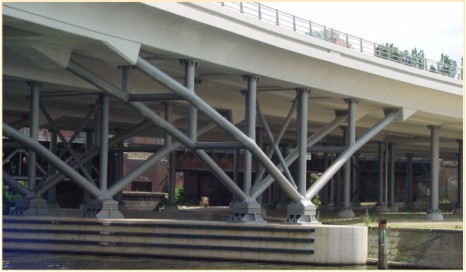CIDECT 7W: Fatigue of end- to- end chs connections
Introduction
In the long history of steel bridge building, many bridges were build with cast iron. With the implementation of carbon steel as a result of modern manufacturing advances, cast iron was replaced with steel due to its unfavourable characteristics. The situation has changed in the last 10 years. Improvements in the material properties have been made and cast steel with properties comparable to modern carbon steel is now available to engineers and architects.
It is noteworthy, that architects in Germany are beginning to use the new cast steel in combination with structural hollow sections for aesthetic improvements in structures. Among them, the tree structures for columns of bridges and other buildings, which lead to a slender and optically very pleasing design, is more frequently being used. But this is not the only application of this material in bridges. New ways, especially in major projects, are being considered and many advantages are seen in the use of cast steel. Complicated joint types are easily manufactured and the shape can be optimised for the distribution of forces. The stress concentration is reduced, which is very important for fatigue behaviour.

However, due to the rare use of cast steel, the special properties of the various grades of cast steel are not widely known. The advantages are unknown to a majority of civil engineers and the existing rules and design guides are seldom sufficient. More experience on this field is required.
Therefore, new design guides, dealing particularly with cast steel, have been developed. Specific details, mainly relevant to the material, are included in the new standards. Special problems relating to casting failures and differences with respect to carbon steel are dealt with. Detailed information about these problems will be given in the second interim report to this project at the next CIDECT meeting in 2003.
To show the progress in this field derived from the practical use of structural hollow sections and cast steel in bridges, different examples of usage are presented on the following pages as a first minor part of an extensive literature study. Major projects which extend the knowledge of the behaviour of this material and common usage in minor projects demonstrate the competitiveness compared to conventional structures. As will be shown, the application of hollow sections in bridges can be multifaceted and elegant.

